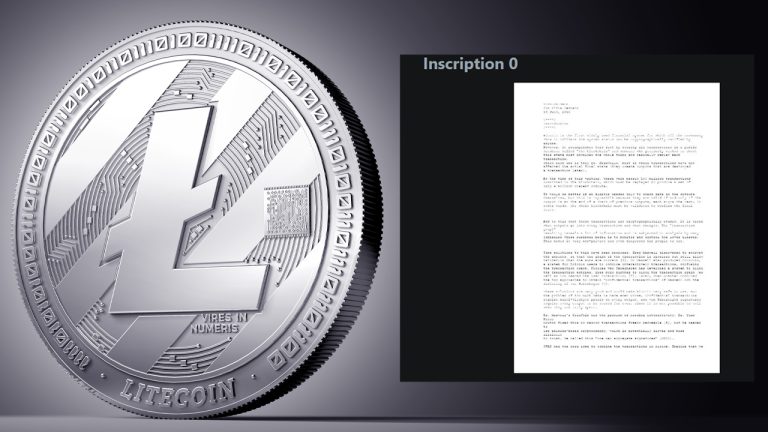 The Internet Computer Protocol (ICP) has integrated threshold-Schnorr signatures and onchain Bitcoin block headers as part of its Deuterium milestone. This development aims to expand the utility of Bitcoin within the decentralized economy, allowing for new applications previously hindered by Bitcoin’s lack of native smart contract support. ICP Introduces Threshold-Schnorr Signatures to Boost Bitcoin Compatibility […]
The Internet Computer Protocol (ICP) has integrated threshold-Schnorr signatures and onchain Bitcoin block headers as part of its Deuterium milestone. This development aims to expand the utility of Bitcoin within the decentralized economy, allowing for new applications previously hindered by Bitcoin’s lack of native smart contract support. ICP Introduces Threshold-Schnorr Signatures to Boost Bitcoin Compatibility […] Olaoluwa Osuntokun, co-founder and CTO of Lightning Labs, recently executed the first successful mainnet multi-hop asset payment using Taproot Asset channels, marking a new development in asset transfer capabilities over the Lightning Network. Asset Transfer Achieved on Lightning Network Using Taproot Channels The transaction, conducted by Osuntokun, involved a multi-hop payment using a digital asset […]
Olaoluwa Osuntokun, co-founder and CTO of Lightning Labs, recently executed the first successful mainnet multi-hop asset payment using Taproot Asset channels, marking a new development in asset transfer capabilities over the Lightning Network. Asset Transfer Achieved on Lightning Network Using Taproot Channels The transaction, conducted by Osuntokun, involved a multi-hop payment using a digital asset […]
The author of the white paper, Robin Linus, based BitVM’s architecture on Ethereum’s optimistic rollups with fraud proofs and recent Merkle tree developments.
A Bitcoin developer has proposed a new way to bring more expressive off-chain smart contracts to Bitcoin (BTC) without needing a soft fork.
Announced in an Oct.9 white paper titled “BitVM: Compute Anything on Bitcoin” by ZeroSync’s project lead Robin Linus, BitVM enables Turing-complete Bitcoin contracts without altering Bitcoin’s consensus rules.
"Any computable function can be verified on Bitcoin"https://t.co/Itf9UHos0C pic.twitter.com/CLQv49Ydsg
— яobin linus (@robin_linus) October 9, 2023
A Turing Complete system is one which can theoretically provide an answer to any computational problem.
With BitVM, the “logic” of Bitcoin contracts would be executed off-chain but verification would be made on Bitcoin — similar to Ethereum’s optimistic rollups.
BitVM’s architecture is based on fraud proofs and a challenge-response model where a “prover” can make claims and a “verifier” can perform a fraud-proof to punish the prover when false claims are made.
Linus explained that Bitcoin, in its current form, is limited to basic operations, such as signatures, timelocks, and hashlocks — but that can now be broadened with BitVM, which Linus says can compute a host of interesting applications.
“Potential applications include games like Chess, Go, or Poker, and particularly, verification of validity proofs in Bitcoin contracts.”
“Additionally, it might be possible to bridge BTC to foreign chains, build a prediction market, or emulate novel opcodes,” said Linus.
Linus said a limitation of the model is that it is limited to a two-party setting with a prover and a verifier and that a significant amount of off-chain computation and communication is needed to execute programs.
Linus said the next “milestone” is to fully implement the BitVM in addition to Tree++ — a high-level programming language to write and debug Bitcoin contracts.
BitVM is enabled by the Taproot soft fork which took place in November 2021.
Linus cited Ethereum research into optimistic rollups and a study on Merkle Trees in contributing to the eight-page white paper.
Prominent Bitcoiner Eric Wall posted on X (Twitter) that the concepts outlined in the BitVM white paper “check out” and is “cautiously excited” to see what real-world experiments stem from it.
Bitcoin analyst Dylan LeClair is also impressed with BitVM’s white paper. But Adam Back, a Bitcoin Core contributor suggested that people shouldn’t get too excited about the development just yet.
for people getting (over) excited, this is cool but effectively a generalization of a two-party game - it says right in the abstract - so it's a bit like Greg Maxwell's 2016 ZKP contingent payments implemented example https://t.co/OeHRsbFjud
— Adam Back (@adam3us) October 9, 2023
Related: BIP-300 biff: Debate reignites over years-old Bitcoin Drivechain proposal
One builder in the blockchain space, “dotta,” noted that there is already a proof-of-concept on GitHub.
Another X user, Sam Parker, attempted to resolve a common fear among Bitcoin maximalists by explaining that BitVM won’t force Bitcoin’s to be “locked” into these contracts.
“Finally, this is opt-in. If you don’t trust your coins being locked to some Turing complete contract (totally reasonable) then don’t lock them to a Turing complete smart contract. One of [the] beauties of the UTXO system is security sandboxing.”
Others, such as “psage” say BitVM adds to the list of things that will push Bitcoin’s price forward in the next bull market.
The bullish stuff around #Bitcoin is snowballing, lots of them controversial, nevertheless a few off my finger tips:
— psage (@perspiringsage) October 9, 2023
- BitVM
- Ordinals
- Multiple Pres Candidates talking about it
- ETF
- Halving
- Privacy improvements
- Exponential Hash Rate increase
- Countries mining
....
Cointelegraph contacted Linus for comment but did not receive an immediate response.
Magazine: Wolf Of All Streets worries about a world where Bitcoin hits $1M: Hall of Flame

Lightning Labs have unveiled a new solution to the clunky process for minting new assets on the Bitcoin network.
Bitcoin (BTC) users have been given a possibly more efficient way to mint new assets on the blockchain aft an updated edition of the recently-rebranded Taproot Assets Protocol was released by Lightning Labs.
In a May 16 blog post, Lightning Network infrastructure firm Lighting Labs criticized the current methods by which assets are inscribed on the Bitcoin blockchain calling them “particularly efficient” and pointed to cumbersome protocols that write asset metadata “directly into block space.”
Today we're excited to announce the newest version of Taproot Assets , a scalable protocol to issue assets on #bitcoin and Lightning.
— Lightning Labs⚡️ (@lightning) May 16, 2023
With this release, developers have the core set of features to bitcoinize the dollar in a chain-efficient manner! ⛓️https://t.co/7WmeDjNnM2
The Taproot Assets Protocol is designed to operate “maximally off-chain” in order to avoid the network congestion that has become an unfortunate characteristic of the Bitcoin network since the inception of the BRC-20 token standard by anonymous developer “Domo” on March 8.
Lightning Labs said Protocol users can soon integrate BRC-20 assets into the Lightning Network, with wallets, exchanges and merchants ported over instead of needing to “bootstrap a new ecosystem” from scratch.
Domo has previously said the Taproot Assets Protocol is a far “better solution” for minting new assets on Bitcoin when compared to the pre-existing methods like JavaScript Object Notation (JSON), as it allows for users to easily transfer to the Lightning network for “fast and cheap transactions.”
The overwhelming majority of BRC-20 tokens created thus far utilize Ordinal inscriptions of JSON data to deploy token contracts, mint tokens and transfer them.
This method has drawn widespread criticism from developers who claim the process costs four times as much in transaction fees compared to if they just used binary.
The Taproot Assets Protocol is the rebranded version of the original “Taro” protocol. Lightning Labs was forced to change the name of the software following what it called a “frivolous” trademark infringement suit filed against them by blockchain development firm Tari Labs on Dec. 8 last year.
Related: Ordinals and BRC-20 will disappear in a matter of months, says JAN3 CEO
The total value of BRC-20 tokens briefly surpassed the $1 billion mark on May 9 but has since shrunk back down to $500 million, a drop of nearly 50%.

Magazine: $3.4B of Bitcoin in a popcorn tin — The Silk Road hacker’s story

Tari Labs, who bought the suit against the project has faced backlash from the crypto community with some suggesting the lawsuit was “frivolous.”
Bitcoin (BTC) software firm Lightning Labs and blockchain startup Tari Labs have agreed to convert a court-ordered temporary restraining order that halts the development of Lightning's Taro protocol.
In a March 15 filing, lawyers for both Lightning and Tari proposed converting the restraining order to a preliminary injunction — a temporary order that prevents a party from undertaking certain actions.
The order's conversion to a preliminary injunction would stop the development of the protocol until a court decision is reached.
The two firms agreed that Lightning would still not make updates to the Taro protocol, merge internal updates with the protocol's public-facing open-source code and could not announce or otherwise launch "the next stage or 'milestone' of the TARO protocol."
Lightning was permitted, however, to respond to communications from non-Lightning developers and users, if it does not use those communications to further Taro's development.
It could also reference Taro as the "prior name of the protocol" for announcements pertaining to changing the protocol's name — as long as it was "not confusingly similar" to Taro or Tari.
The temporary restraining order was issued on March 13 by California District Court Judge William Orrick after Tari Labs said the name “Taro” infringed on its trademark rights as it was too similar to its own protocol named “Tari” — a registered trademark in the United States.
As a result, Lightning Labs has been unable to make updates to or regarding the Taro protocol.
Tari Labs first filed a complaint for trademark infringement against Lightning Labs on Dec. 8, alleging both firms “compete in the same digital blockchain ecosystem” and provide similar, “in some cases identical,” services.
Both firms also “market to similar developers and users, and appear on the same blockchain platforms,” according to Tari.
Related: DeFi on Bitcoin is possible with this new Layer 2: AMA with Mintlayer
News of the restraining order prompted a backlash on Twitter. Tari Labs co-founder, Riccardo Spagni, defended the lawsuit, arguing in a March 15 tweet that the letters “I” and “O” are close enough together on a computer keyboard to cause confusion and that Tari offered to fund Taro’s rebrand a year ago.
On the contrary - if you don’t defend a trademark you literally lose it. Also the i and o are next to each other on the keyboard; their own counsel mistyped it. Last thing I’ll say is that we (1) reached out ages ago, multiple times, via email / Twitter DM / in person at a… https://t.co/k65HU4xKfp
— Ric “el pony esponjoso” (@fluffypony) March 15, 2023
The lawsuit was similarly defended by Tari co-founder, Naveen Jain, who suggested in response to a Twitter user calling the suit “frivolous” that it was “it’s hard to call something ‘frivolous’ when a judge issues a temporary restraining order in your favor.”
you are welcome to your opinion. That said, it's hard to call something "frivolous" when a judge issues a temporary restraining order in your favor.
— Naveen (,) (@NaveenSpark) March 16, 2023
Lightning Labs develops software for the Lightning Network, a Layer 2 solution for the Bitcoin blockchain which allows for transactions that are cheaper and faster than those executed on the base layer.
Its Taro protocol is an ambitious project which was announced on April 5 amid a $70 million funding round and plans to build upon Bitcoin’s Taproot upgrade and allow stablecoins to be transferred via the Lightning Network.
 Following a growing trend of Ordinal inscriptions on the Bitcoin blockchain, the technology has been ported to the Litecoin network, and the number of onchain Litecoin inscriptions has surpassed 13,000. Software developer Anthony Guerrera made Ordinal inscriptions on the Litecoin network possible by receiving 22 Litecoin to port the technology to the proof-of-work (PoW) blockchain. […]
Following a growing trend of Ordinal inscriptions on the Bitcoin blockchain, the technology has been ported to the Litecoin network, and the number of onchain Litecoin inscriptions has surpassed 13,000. Software developer Anthony Guerrera made Ordinal inscriptions on the Litecoin network possible by receiving 22 Litecoin to port the technology to the proof-of-work (PoW) blockchain. […] On Monday, crypto proponent Udi Wertheimer shared a story on Twitter explaining how he and the Taproot Wizards helped an artist who created the original 2013 bitcoin wizard meme raise nearly $150,000 in bitcoin. While the minting and sale were successful, Wertheimer explained that bitcoin maximalists and the r/bitcoin moderator Bashco disliked it. Artist Who […]
On Monday, crypto proponent Udi Wertheimer shared a story on Twitter explaining how he and the Taproot Wizards helped an artist who created the original 2013 bitcoin wizard meme raise nearly $150,000 in bitcoin. While the minting and sale were successful, Wertheimer explained that bitcoin maximalists and the r/bitcoin moderator Bashco disliked it. Artist Who […] According to the latest statistics, more than 100,000 ordinal inscriptions have been added to the Bitcoin blockchain since the start of the trend. Amid the growing popularity, people have launched supporting marketplaces and tools that allow individuals to inscribe without a full node. Additionally, a decentralized Ordinal exchange is reportedly in the works. 100,000 Inscriptions […]
According to the latest statistics, more than 100,000 ordinal inscriptions have been added to the Bitcoin blockchain since the start of the trend. Amid the growing popularity, people have launched supporting marketplaces and tools that allow individuals to inscribe without a full node. Additionally, a decentralized Ordinal exchange is reportedly in the works. 100,000 Inscriptions […] During the past two weeks, members of the cryptocurrency community have discussed the non-fungible token (NFT) concept known as Ordinals. Since the 3.96 MB block (#774,628) was mined, there has been a significant increase in Ordinal inscriptions on the Bitcoin blockchain. Ordinal Inscriptions on Bitcoin Blockchain Spark Debate Among Crypto Community The controversial NFT concept […]
During the past two weeks, members of the cryptocurrency community have discussed the non-fungible token (NFT) concept known as Ordinals. Since the 3.96 MB block (#774,628) was mined, there has been a significant increase in Ordinal inscriptions on the Bitcoin blockchain. Ordinal Inscriptions on Bitcoin Blockchain Spark Debate Among Crypto Community The controversial NFT concept […] Amid the controversy surrounding the Ordinals project and the debate over what types of data should be stored on the Bitcoin blockchain, the network mined its largest block, nearly 4 MB in size, containing just 63 transactions. One of the transactions was a 3.94 MB Ordinal inscription featuring an image of a wizard, and the […]
Amid the controversy surrounding the Ordinals project and the debate over what types of data should be stored on the Bitcoin blockchain, the network mined its largest block, nearly 4 MB in size, containing just 63 transactions. One of the transactions was a 3.94 MB Ordinal inscription featuring an image of a wizard, and the […]